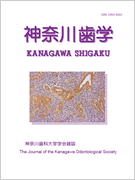- HOME
- > 一般の方
- > バックナンバー:神奈川歯学
- > 16巻4号
- > アブストラクト
アブストラクト(16巻4号:神奈川歯学)

Japanese
| Title : | ミリングカッター性能の客観的評価法について |
|---|---|
| Subtitle : | 原著 |
| Authors : | 原橋豊信, 宇治文孝, 山下和子, 白沢勝沖, 松尾悦郎 |
| Authors(kana) : | |
| Organization : | 神奈川歯科大学補綴学教室第一講座 |
| Journal : | 神奈川歯学 |
| Volume : | 16 |
| Number : | 4 |
| Page : | 539-550 |
| Year/Month : | 1982 / 3 |
| Article : | 原著 |
| Publisher : | 神奈川歯科大学学会 |
| Abstract : | 「緒言」 近年, パーシャル・デンチャーの支台装置としてのアタッチメントの普及は注目すべきものがある. アタッチメントは, 松尾, 津留, H.W.Preiskel, 中沢, 雨森, 丸山等の分類によれば, 既製と自家製に大別され, 後者の大部分はバーとテレスコープクラウンをミリングテクニックと呼ばれる方法によって製作されたものである. これらは, 維持力に優れ, 義歯の動きが少ないため咀嚼機能が改善されやすく, 既製アタッチメント義歯と同様に審美性にも優れている. 特にテレスコープクラウンにおいては, I.R.Vシステムのように歯周病に対して積極的に予防および組織の保護を目的とした方法も考えられている. 多くの利点を有しているこれらの精密作業は, 現在では技術および材料の進歩により製作法も容易化され広く普及しつつある. ミリングテクニックの全ての種類に共通する要素は固定部(内冠)と可撤部(外冠)の摩擦力による維持であり, その主体となる術式はその名の示す通り内冠のミリングである. |
| Practice : | 歯科学 |
| Keywords : |
English
| Title : | An Objective Method for Evaluating Cutter Capabilities |
|---|---|
| Subtitle : | Original article |
| Authors : | Toyonobu HARAHASHI, Fumitaka UJI, Kazuko YAMASHITA, Katsuoki SHIRASAWA, Etsuro MATSUO |
| Authors(kana) : | |
| Organization : | 1st Department of prosthetic Dentistry, Kanagawa Dental College |
| Journal : | Kanagawa Shigaku |
| Volume : | 16 |
| Number : | 4 |
| Page : | 539-550 |
| Year/Month : | 1982 / 3 |
| Article : | Original article |
| Publisher : | Kanagawa Odontological Society |
| Abstract : | Abstract : There has been an increase in cases where the retainer is constructed with a milling technique. As basic research on this, we sought an objective evaluation method to investigate from several angles the tool-life and cutting efficiency of a dental milling cutter for use in milling in the matrix. we report our findings below. Using a cutter made of tungsten-vanadium steel and one made of tungsten-carbide steel where the blade number and the diameter was the same but where the direction of spiral was different we performed a cutting depth test on two types of test-pieces where the respective hardnesses were Hv 150 and Hv 250 in order to determine the tool-life and cutting efficiency of each cutter. 1) The carbide cutter was superior in both tool-life and cutting efficiency. 2) With cutters made from the same material a leftward direction of spiral was superior to a rightward direction. 3) We determined that our own unique tool-life equation which incorporates the thinking of G.A.Lammie into Taylor's tool-life equation was an effective method for objectively evaluating cutter capabilities. |
| Practice : | Dentistry |
| Keywords : |
